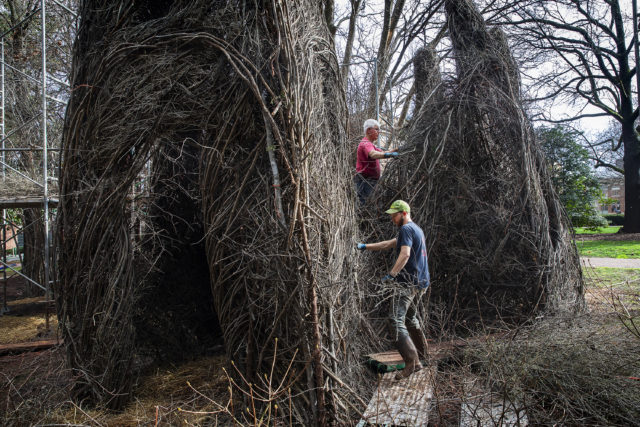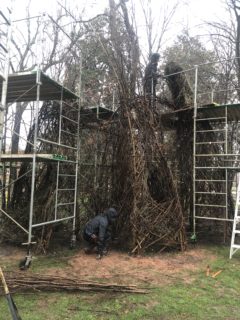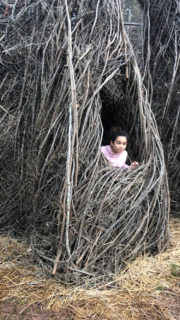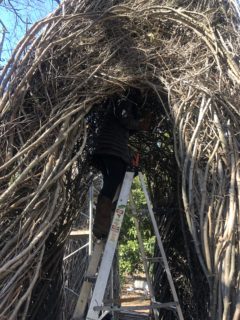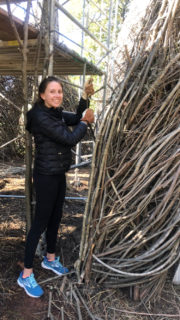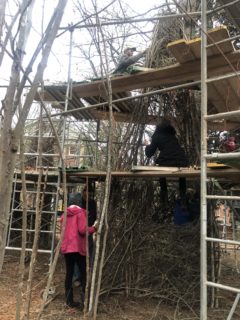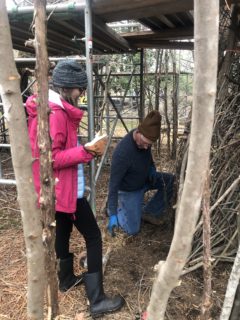From February 2nd to the 21st, Davidson students have been lucky to witness an entirely new sculpture being built by self-described “stick sculpture artist”, Patrick Dougherty, located on a piece of land between the union and the library. Similar to the Baik residency in the fall semester, this commission is unique in that the campus can watch as it is actively constructed through collaboration between Dougherty, students, and community members. This piece is only a small part of Dougherty’s legacy of environmental artwork scattered across the globe, and we are lucky to witness this new sculpture become an important sculptural presence at Davidson.
Dougherty himself already has a connection to North Carolina, as he grew up in the state after being born in Oklahoma in 1945. Attending the University of North Carolina first for English and later for Art History and Sculpture, Dougherty built his entire practice upon the principle of experimentalism and primitive construction with tree saplings. The monumental size, along with the elegant and woven texture and harmonious interaction with the surrounding environment, make Dougherty’s work completely unique and recognizable in today’s art world, though no two pieces of his are the same. He has built over 250 sculptures internationally, with many of them being built on college campuses. In fact, I grew up visiting and playing in one of Dougherty’s pieces at Bowdoin College in my hometown of Brunswick, ME (built in 2001), which only proves the massive scope of his influence.
The most remarkable facet of Dougherty’s work is how ethereal and delicate these structures look, despite their monumentality. There is a mix of whimsy and practicality, as well, for onlookers can gain so many varied experiences and meanings from the single work. When I was a toddler, Dougherty’s sculpture in Maine felt like a castle to me, and I was able to run through all of the nooks and crannies freely – it didn’t feel like art, only a structure I could play and pretend in. Now, coming from the point of view of an art student here at Davidson, I am able to see the complex construction, the mix of carpentry and art, and the unique mark-making that the sticks and saplings allow for. However, even the most trained eye cannot see how such a structure is built. The flowing wave of interwoven saplings on the exterior covers any view of infrastructure or support, and the curves, windows, and doorways into the piece give a sense of cohesion between nature and art, a tension between the artificial and the natural. In a sense, Dougherty does the impossible; he makes the most complex artistic statement look easy, like it is simply a constantly moving and bending tree in nature.
Additionally, I see there to be a subtle message of advocacy and hope in Dougherty’s work that I didn’t realize until physically constructing the piece. There is a tenaciousness to its construction that mimics nature’s strength and power. The sculpture stands through all environmental conditions and disasters, and even its creation throughout the past two weeks was not stopped by rain or snow, as the builders remained on site no matter the weather. This type of persistence and perseverance to me is hopeful and inspiring. Further, because it is semi-permanent, the ability to appreciate the piece in its totality is limited to only a few years. As opposed to other sculptures on campus that can remain indefinitely, the natural and therefore perishable materials of Dougherty’s work make every moment the sculpture stands even more special. Like all things in nature, this piece belongs to the cycle of life, so we must do all we can to make it last through all impending environmental changes.
Students in Professor Cort Savage’s sculpture class have actively been working on the site, in addition to gallery interns, art and art history students, faculty, staff, and community members. Speaking from personal experience, it was incredible to work alongside Patrick and his son, as I felt like my hand was helping to shape the sculpture in small but necessary ways. As this will probably be standing for around two years on campus before being taken down, the legacy of this sort of collaboration between the Davidson community and such a world-renowned artist will last well beyond this month. Be sure to attend the reception happening today, February 21st, first at the site and then in the Hamilton W. McKay Atrium, E. Craig Jr. Wall Academic Center, and continue to visit the site as the seasons change here in North Carolina.

